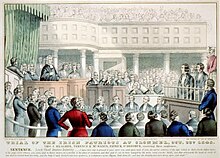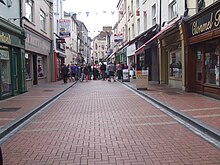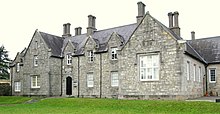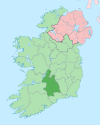Clonmel
With the exception of the townland of Suir Island, most of the borough is situated in the civil parish of "St Mary's"[2] which is part of the ancient barony of Iffa and Offa East.
There were originally three gates in the walled town, North, East and West – with the South being protected by the river Suir and the Comeragh Mountains.
Muiris Mac Ionrachtaigh, chaplain and confessor to the Rebel Earl of Desmond, was taken prisoner upon Sliabh Luachra and taken to Clonmel for imprisonment, while he continued his priestly ministry to the best of his ability.
[6] According to historian James Coombes, the former location of Victor White's house near Lough Street in Clonmel continued to be nicknamed "Martyr Lane" until well into Cromwellian times.
Muiris Mac Ionrachtaigh was beatified by Pope John Paul II, along with 16 other Irish Catholic Martyrs, on 27 September 1992.
That night, O'Neill, deciding that further resistance was hopeless due to a lack of ammunition, led his soldiers and camp followers out of the town under cover of darkness.
The story is told that Cromwell became suspicious of O'Neill's desperate situation when a silver bullet was discharged by the townspeople at his troops outside the walls.
[11] The following morning, 18 May 1650, mayor John White was able to surrender the town on good terms as Cromwell was still unaware of the garrison's escape just hours before.
On 26 April, he was tried by a jury and Commonwealth judges, including Colonel Solomon Richards, for violating the Proclamation of 6 January 1653, which defined it as high treason for priests to remain in Ireland.
[16] During the second half of the 18th century, the Sean-nós song Príosún Chluain Meala was composed inside Clonmel Gaol by one O'Donnell, a member of the Whiteboys originally from Iveragh, County Kerry, who was being held awaiting execution by hanging upon the following Friday.
According to Donal O'Sullivan, O'Donnell had two companions awaiting the rope with him and that their heads were posthumously severed from their bodies and displayed spiked upon the prison gates.
"The Gaol of Cluain Meala", an English translation of the lyrics, was made by County Cork poet Jeremiah Joseph Callanan (1795–1829).
"[19] Following the failed attempt at rebellion near Ballingarry in 1848, the captured leaders of the Young Irelanders were brought to Clonmel for trial.
[20] The event was followed with great interest internationally and for its duration brought journalists from around the country and Britain to Clonmel Courthouse.
Property omitted from Phase 1 along the Convent Road were protected in 2014 and the access to the river for the workmen's boat club was also raised.
[citation needed] The 2016 census used a new boundary created by the Central Statistics Office (CSO) to define the town of Clonmel and environs, resulting in a population figure of 17,140.
Sepam has been involved in several large infrastructure projects around the world such as the Queen Elizabeth Olympic Park in London, Disneyland Shanghai and some of the terminals at Heathrow Airport.
This led to the first editor being jailed under the Coercion Act on charges that he had intimidated a cattle dealer for taking a farm from which tenants had been evicted.
[citation needed] The Sporting Press, also published and printed in Clonmel, covers news related to the greyhound community in Ireland.
It was used in the past as a Tholsel or office to collect tolls, duties and customs dues, a place for civic gatherings and as a court.
[citation needed] The White Memorial Theatre building is a former Wesleyan/Methodist Chapel and was designed and built by local architect William Tinsley in 1843.
It was soon followed by John Magner's Theatre at the Mall, which burned to the ground in 1919, to be re-built in 1921 with an increased capacity of over a thousand seats.
[65] Music venues in Clonmel include The Piper Inn, which previously hosted a show by Irish rock band Thin Lizzy.
[citation needed] Vertue rewarded, or The Irish princess (1693), one of the earliest romance novels written in the English language, tells the story of "Merinda" from High Street, Clonmel and a Williamite officer stationed in the town during the Jacobite war.
[citation needed] Clonmel Rowing Club (CRC), founded in 1869, is located about 500 meters west of the town centre.
In 2007, the club undertook the restoration of the historic racing craft Cruiskeen, which was built in the 1840s by GAA founder member Maurice Davin.
[76] The project took several years of cleaning, treatment and repair and the 38 ft./11.6m timber boat is now on permanent display in the County Museum, Clonmel.
[87] The English-medium school, Raheen College (or Coláiste Chluain Meala), is co-educational and under the control of the local Education and Training Board.
Charles Bianconi, onetime mayor of the town, ran his pioneering public transport system of horse-drawn carriages from Clonmel.
[96] Today there are two trains daily to Waterford via Carrick on Suir, and two to Limerick Junction (for main-line connections to Dublin), via Cahir and Tipperary town.













